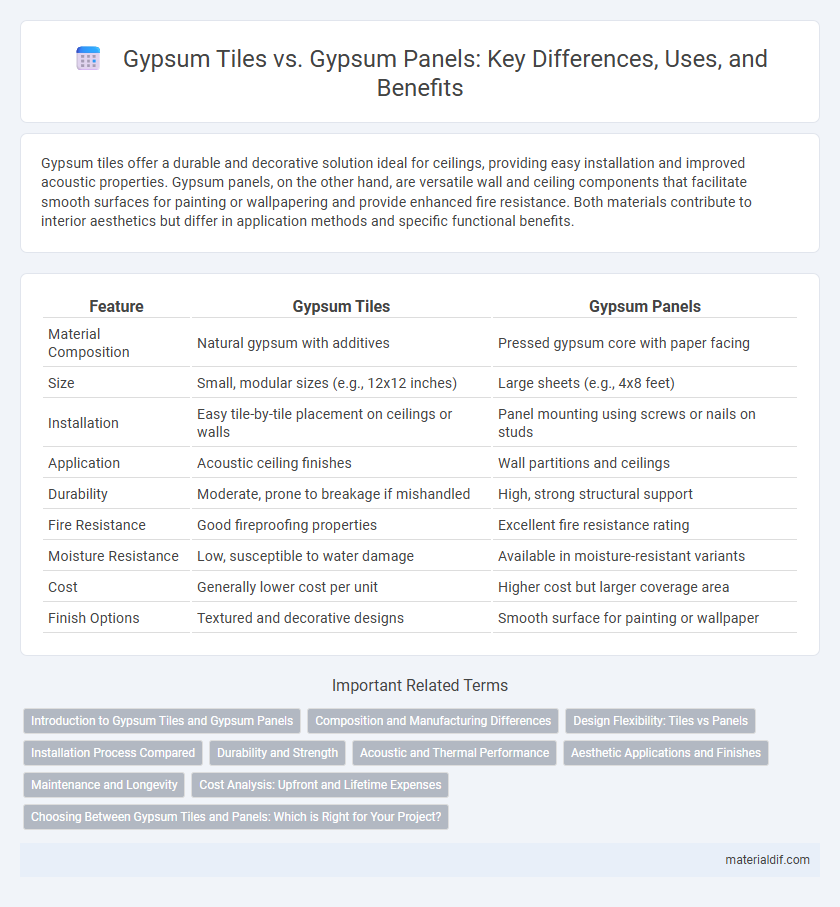Gypsum tiles offer a durable and decorative solution ideal for ceilings, providing easy installation and improved acoustic properties. Gypsum panels, on the other hand, are versatile wall and ceiling components that facilitate smooth surfaces for painting or wallpapering and provide enhanced fire resistance. Both materials contribute to interior aesthetics but differ in application methods and specific functional benefits.
Table of Comparison
| Feature | Gypsum Tiles | Gypsum Panels |
|---|---|---|
| Material Composition | Natural gypsum with additives | Pressed gypsum core with paper facing |
| Size | Small, modular sizes (e.g., 12x12 inches) | Large sheets (e.g., 4x8 feet) |
| Installation | Easy tile-by-tile placement on ceilings or walls | Panel mounting using screws or nails on studs |
| Application | Acoustic ceiling finishes | Wall partitions and ceilings |
| Durability | Moderate, prone to breakage if mishandled | High, strong structural support |
| Fire Resistance | Good fireproofing properties | Excellent fire resistance rating |
| Moisture Resistance | Low, susceptible to water damage | Available in moisture-resistant variants |
| Cost | Generally lower cost per unit | Higher cost but larger coverage area |
| Finish Options | Textured and decorative designs | Smooth surface for painting or wallpaper |
Introduction to Gypsum Tiles and Gypsum Panels
Gypsum tiles and gypsum panels are essential building materials derived from calcium sulfate dihydrate, widely used for interior walls and ceilings. Gypsum tiles are smaller, modular units ideal for decorative uses and quick installation, offering fire resistance and sound insulation. In contrast, gypsum panels are larger, flat sheets designed for structural applications, providing durability, ease of finishing, and moisture resistance in construction projects.
Composition and Manufacturing Differences
Gypsum tiles are typically composed of high-purity gypsum powder combined with additives like fiberglass for strength, compressed into small, dense panels through a dry process. In contrast, gypsum panels consist of a gypsum core sandwiched between paper facings, created via a continuous slurry deposition method that allows for larger, uniform sheets. Manufacturing differences affect their moisture resistance and structural applications, with tiles offering increased durability and panels favoring ease of installation and surface finishing.
Design Flexibility: Tiles vs Panels
Gypsum tiles offer versatile design options with customizable sizes, patterns, and textures ideal for intricate ceiling and wall designs, allowing easy installation and replacement of individual tiles. Gypsum panels provide larger, continuous surfaces suitable for smooth finishes and structural integration, supporting seamless walls and ceilings with fewer joints and enhanced durability. Choosing between gypsum tiles and panels depends on the desired aesthetic complexity and installation scale, with tiles favoring decorative flexibility and panels emphasizing uniformity and robustness.
Installation Process Compared
Gypsum tiles offer a straightforward installation process, typically involving a simple adhesive application and quick setting times, making them ideal for rapid projects and small-scale renovations. Gypsum panels require mechanical fastening with screws or nails onto a metal or wooden framework, demanding more precise measurements and skilled labor for proper alignment and joint finishing. The tile installation is less labor-intensive but may lack the structural benefits and surface uniformity provided by the panel system.
Durability and Strength
Gypsum panels offer greater durability and strength compared to gypsum tiles, making them ideal for structural applications and load-bearing walls. The dense composition and reinforced fiberglass mesh in gypsum panels enhance resistance to impact, moisture, and cracking. Gypsum tiles, while lightweight and easy to install, generally provide less robustness and are more vulnerable to damage under stress or heavy use.
Acoustic and Thermal Performance
Gypsum tiles provide superior acoustic insulation due to their density and surface texture, effectively reducing sound transmission in residential and commercial spaces. Gypsum panels offer enhanced thermal performance by acting as an excellent thermal barrier, helping maintain consistent indoor temperatures and improving energy efficiency. Both materials contribute to improved building comfort, but gypsum panels are generally preferred where thermal regulation is a primary concern.
Aesthetic Applications and Finishes
Gypsum tiles offer versatile aesthetic applications with a variety of decorative finishes such as textured surfaces, vibrant paints, and intricate patterns, making them ideal for customizable interior design elements like ceilings and wall accents. In contrast, gypsum panels provide a smooth, uniform surface that serves as a perfect base for seamless paint finishes and wallpaper applications, contributing to sleek and modern interior aesthetics. Both materials enhance interior environments, but gypsum tiles emphasize decorative detail while gypsum panels prioritize clean, minimalist finishes.
Maintenance and Longevity
Gypsum tiles require regular sealing and careful handling to prevent chipping and moisture damage, which can reduce their lifespan. Gypsum panels, often treated with water-resistant coatings and reinforced materials, offer greater durability and lower maintenance needs in wet or high-traffic areas. Proper installation and maintenance of gypsum panels can extend their longevity, making them a more cost-effective solution over time compared to gypsum tiles.
Cost Analysis: Upfront and Lifetime Expenses
Gypsum tiles generally have a lower upfront cost compared to gypsum panels, making them a budget-friendly option for short-term projects or small-scale renovations. However, gypsum panels offer better durability and moisture resistance, which can reduce maintenance and replacement expenses over their lifetime. Considering total costs, gypsum panels often provide greater long-term value despite the higher initial investment.
Choosing Between Gypsum Tiles and Panels: Which is Right for Your Project?
Gypsum tiles offer a versatile and decorative solution with easy installation and moisture resistance, making them ideal for ceiling designs and small-scale renovations. Gypsum panels provide superior structural strength and sound insulation, suitable for large wall coverings and commercial projects requiring durability. Selecting between gypsum tiles and panels depends on project scale, aesthetic preference, and functional requirements such as moisture control and acoustic performance.
Gypsum tiles vs Gypsum panels Infographic

 materialdif.com
materialdif.com